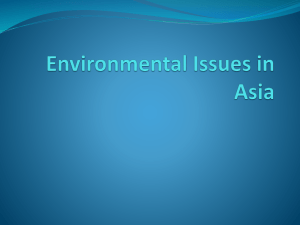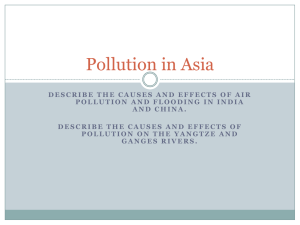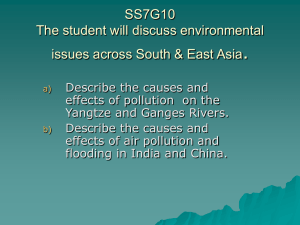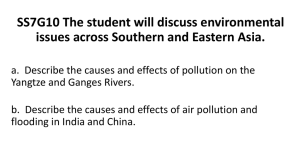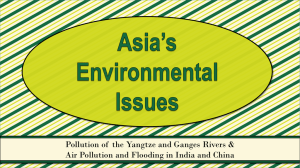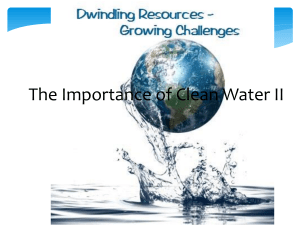Environmental Issues - Polk School District
advertisement
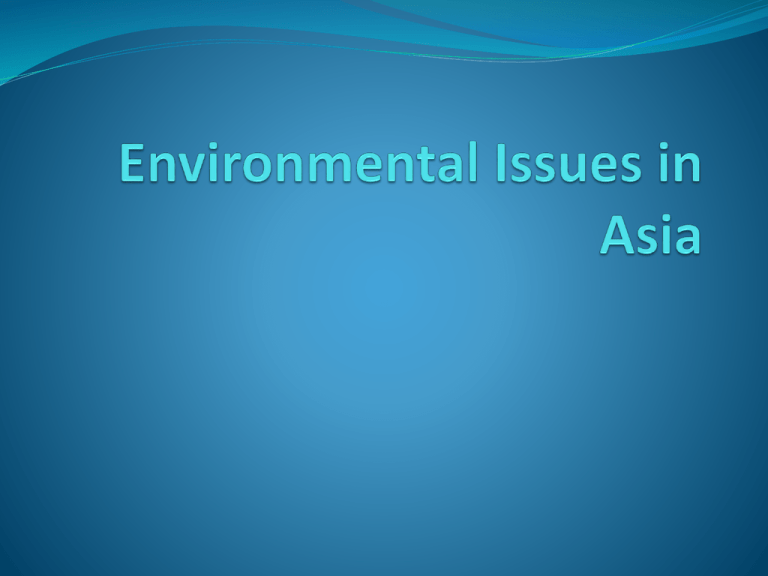
Essential Question How are humans responsible for their environment? Standards SS7G10 The student will discuss environmental issues across Southern and Eastern Asia. a. Describe the causes and effects of pollution on the Yangtze and Ganges Rivers. b. Describe the causes and effects of air pollution and flooding in India and China. a. Describe the causes and effects of pollution on the Yangtze and Ganges Rivers YANGTZE RIVER 400 million people (1/3 of China’s population live along the banks of the YangtzeRiver Billions of tons of chemicals and waste from agriculture, industry, and people pour into the river every year. Because of the river’s vast size, the pollution is somewhat diluted. Nevertheless, the nitrates from farm runoff enable algae to multiply, decreasing oxygen that fish need to survive. Pollution has killed the smaller fish in the river and harmed the larger ones, so that many people are afraid to eat any fish caught there. Hundreds of millions of Chinese villagers do not have safe drinking water because water sources like lakes, rivers, and aquifers have been polluted by industry. Cities have also been affected. When water quality is tested and water is too polluted to drink: city residents drink bottled water. Schools sometimes close Fishing village in Jiangse Providence Pollution in the Yangtze River Fish market in Wuhan Ganges River Pollution the Ganges River is highly polluted with dangerous bacteria about 2 million tons of chemical, human, and agricultural waste are poured into the Ganges daily experts estimate that about 80% of all illnesses and 1/3 of all deaths in India come from diseases carried by dirty water Hindus believe that they will have a peaceful journey to the next life if their ashes are strewn in the Ganges River. Families who cannot afford that process often place the body of their family member in the river instead. Animal carcasses are deposited there as well, adding to an already dangerous situation. In 2001, about 20 million people bathed in the Ganges during a festival of the Hindu religion. Many of India’s sewage systems are simply overwhelmed since they were designed in the early 1900s and haven’t been updated, even though the population in India has soared over the last century. http://www.youtube.com/watch?v=gec1CM N6h0c&feature=player_detailpagehttp://ww w.youtube.com/watch?v=gec1CMN6h0c&f eature=player_detailpage http://www.youtube.com/watch?feature=pla yer_detailpage&v=eeNSOg5XJh4 Essential Question How are humans responsible for their environment? b. Describe the causes and effects of air pollution and flooding in India and China Hold your breath! Industry is growing in China, and air pollution is growing with it. In a recent study by the World Bank, China is home to 16 of the 20 most polluted cities in the world. The World Health Organization (WHO) says that China pumps 1/3 of the world total of pollutants (sulfur dioxide, ozone, nitrogen dioxide) into the world’s air. Smog shrouds buildings in Changsha in Hunan province on January 14. Vehicles move slowly through heavy smog in Beijing on Thursday, January 16. China's manufacturing of exports generates pollution that harms air quality -- not only in Asia but also all the way across the Pacific Ocean in the Western United States, according to a new study. Burning fossil fuels such as coal and petroleum to power Chinese industry and cars is a major source of pollution. Chinese people also burn coal to heat their homes, adding to the pollution problem. A vendor delivers coal briquettes which are mostly used to fuel small coal burners for heating and cooking for low-income homes and restaurants, in an old neighborhood in Beijing. Effects of air pollution: lost work due to illness early deaths chronic bronchitis cancer is leading cause of death in China only 1% of China’s 560 million city dwellers breathes safe air Causes of Pollution Many nations in South, Southeast, and East Asia will now have to worry about the “Asian Brown Cloud” caused by too much pollution in the air. *causes: waste from factories, motor vehicles, forest fires, etc. . Effects of Pollution * It is a brown haze that can alter the paths of monsoons, reduce photosynthesis, and reduce solar radiation to the earth’s surface. India is investing money in cleanup efforts but the growing population outpaces its efforts. The Taj Mahal, a sacred site and popular tourist destination, is growing yellow from pollution. Some experts believe that smog from India and China could possibly change weather patterns in North America. http://video.pbs.org/video/2365104807/ Rain, Rain, Go Away! Monsoon—a seasonal wind bringing heavy rainfall that can lead to flooding Monsoons are a mixed blessing for India Farmers depend on rain for their crops The huge amounts of water are used to generate electricity However, the monsoons cause heavy flooding which makes rivers overflow their banks leading to Terrible destruction Water-borne diseases Annual monsoon rains in China pose the same problems as the rains in India Beneficial to farmers Cause floods, usually every 2 to 3 years Monsoon season in China is March through August Flooding from China’s Huang He has killed more people than flooding from any other river in the world 1887—nearly 2 million died 1931—almost 4 million died Huang He River flows through China’s major farming area and picks up fertile yellow topsoil along its path. The silt builds up so that the river is higher than the surrounding plains. The Chinese have constructed dikes to manage the river. However, when the dikes fail and the river floods, homes and crops are buried and lives are lost. Dike – a dike is a wall to hold water back Monsoon rains also swell the Yangtze River. Flooding is caused by: Loggers working upstream cut down trees that used to help contain flooding (deforestation!) Farmers downstream have drained wetlands that used to act as sponges during floods (wetland loss) These two actions have multiplied the effects of the monsoon rains and cause storm water runoff. It now takes much less water to cause a flood! http://www.youtube.com/watch?v=9peDRk O-TLc&feature=player_detailpage Quiz 1. A study by the World Bank states that China has 16 cities of the 20 most polluted _____________________. 2. As industry grows in China, so does the air pollution _________________. coal fuel to heat their 3. Many Chinese use _______as homes. 4. In India, the two main reasons for increased air industry automobiles pollution are _____________ and ________________. 5. Using unprocessed fuels in cooking emits toxic fumes ____________________. 6. This sacred site and tourist destination is turning Taj Mahal yellow from air pollution. ______________________

